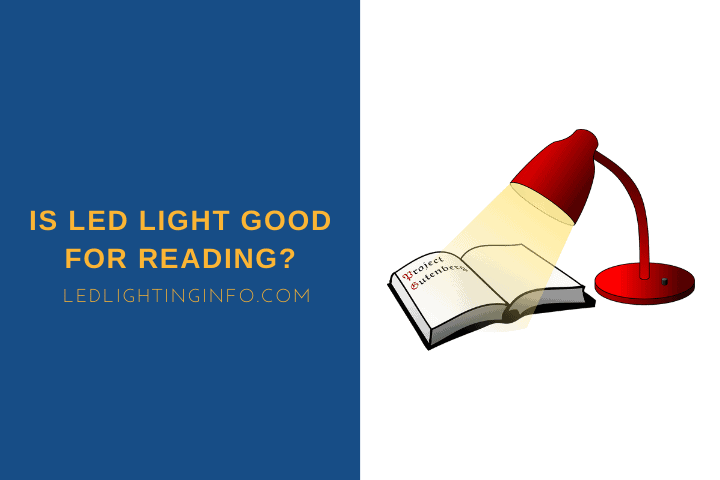Artificial lighting is a fundamental aspect of modern society, and LEDs are rapidly becoming a worldwide favorite. Not only do they last longer than traditional bulbs, but they are also more energy-efficient.
When choosing new lights for your home or office, it’s easy to focus on these positives, but what about the drawbacks of LEDs?
Do LEDs make suitable and comfortable reading lights?
LEDs are a directional light source, which means they emit light in a designated direction. As a result, LEDs make great reading lights. However, it’s important to pay attention to the color temperature and brightness of your LEDs, as choosing the wrong reading light can cause eye strain and impact your sleep cycle.
The LED market is saturated with hundreds of variants of LEDs, and each is better suited to a different situation.
In this article I’ll be setting out:
- The difference between white and yellow LEDs
- The health impact of LEDs
- Why LEDs may cause headaches
- How to choose a suitable reading light
White vs Yellow Colors: Which Light Is Better For Reading?
Most people overlook the impact of bulbs’ colour temperature. Perhaps you’ve even chosen a bulb based on your favourite colour, rather than how suitable it is for its intended purpose? But when it comes to reading, colour temperature makes all the difference.
The color temperature of a bulb is measured in degrees of Kelvin (K), which ranges from 1,000K to 10,000K. A low Kelvin rating indicates that the appearance of the light will be warm, and the bulb will give off red wavelengths. A high Kelvin rating, whereas, indicates that the appearance of the light will be cool, and the bulb will give off blue wavelengths.
The color seen by the naked eye does not necessarily reflect the Kelvin rating, however. When it comes to white LEDs, the whiter a light; the higher the concentration of blue wavelengths. This is because LEDs create white light using a mixture of blue light and yellow phosphor.
This is significant because blue wavelengths are proven to suppress the production of melatonin, the hormone that regulates sleep cycles. Ultimately this means that reading with a white light at bedtime can boost alertness and delay sleep by up to 3 hours.
The upshot of this increased alertness, nevertheless, is that white LEDs are great if you’re reading to work or study. Blue wavelengths aid memory, cognitive functioning, and elevate mood. White-colored LEDs are therefore ideal for offices, studies, and task-orientated areas of your home.
Conversely, yellow LEDs have the opposite effect. The ambient nature of yellow lights causes the mind to feel warm and cozy. This has a relaxing impact, and over prolonged periods will decrease concentration and cause fatigue.
As a less straining solution, yellow lights are, therefore, preferable if you’re reading to relax. Installing warm, yellow LEDs in your bedroom and living room can help you to unwind in the evenings.
Are LED Lights Safe For Eyes?
In the past, consumers had a choice between orange-tinted incandescent and green-tinted fluorescent bulbs. The introduction of blue-tinted LEDs was, therefore, a welcomed innovation. But what, if any, are the health implications of blue wavelengths?
The research found that “exposure to intense and powerful LED light is photo-toxic and can lead to irreversible loss of retinal cells and diminished sharpness of vision.”
This is because blue wavelengths are short and high energy, which allows them to penetrate the eye to the retina. Prolonged or continuous exposure to blue-tinted LEDs can, therefore, result in age-related macular degeneration (AMD), eye strain, and cataracts.
These risks are heightened when it comes to children and teenagers, as their crystalline lenses aren’t fully formed, making them particularly vulnerable.
Furthermore, blue wavelengths also interfere with the circadian rhythm as they suppress the production of melatonin. Interrupting the circadian rhythm can aggravate metabolic disorders such as diabetes, as well as cardiovascular disease and some forms of cancer.
Can LED Lights Cause Headache?
Much like CFLs, LED bulbs continuously flicker at a very fast rate. This is because LEDs can only be completely on or completely off, so they struggle to function at dimmer settings. Even though flickering may not always be visible, our eyes notice the flickers and try to adjust our pupils to keep up.
Scientist Arnold Wilkins notes “LED bulbs switch on and off hundreds of times per second which can lead to symptoms of eye movement dysfunction, double vision, headaches, dizziness and the feeling of being unwell.”
This flickering is sometimes called dirty electricity and is particularly prevalent in cheap LED bulbs. With cheap fittings, due care is not taken to help stabilize and reduce flickering, which leads to more headaches and visual complications.
Though there are now standards in place that govern the amount of flickering that is acceptable.
Individuals are more likely to be affected by dirty electricity if they suffer from light sensitivity, also known as photophobia. Photophobia is a neurological condition that relates to how the eye and the brain communicate with each other.
Whilst most people can tolerate the flickering of LEDs, sufferers of photophobia will experience eyestrain, discomfort, headaches, migraines, excess squinting or blinking, burning or watering of the eye, vertigo, dizziness, and inflammation (TheraSpecs).
How To Pick a Suitable Light For Reading?
With all this information, the task of choosing a new reading lamp may seem daunting. But fear not, because I’ve put together a handy checklist.
- Light temperature: if you’re reading for enjoyment or relaxation purposes, choose a yellow light. If you’re reading for study or work-related purposes, choose a white light.
- Light intensity: A bulb that is too dull will cause eyestrain, as you will struggle to focus on the words you’re reading. Conversely, a bulb that is too bright will be too harsh, which can impede concentration. For reading, I recommend bulbs that are around 450 lumens. This is equivalent to 50 watts.
- Light position: Our eyes are more comfortable when exposed to layers of light, rather than one harsh source. In addition to general overhead lighting, you should use a more focused form of light when reading. This lamp should be positioned close by, perhaps on a bedside table, and it should be adjustable.
- Light distribution: Most LEDs are directional, which means they emit light in a specific direction. This allows light to accurately be cast on your book without disturbing anyone else.
- Light sensitivity: If you suffer from light sensitivity you should consider using organic LEDs. OLEDs produce light using 6 layers and reduce the number of headaches and migraines with this type of light compared to normal LEDs.
Final Words
It is estimated that LEDs will represent nearly half of all lumen sales by the end of 2020. But it’s fair to say that overexposure to LEDs should be avoided.
While LEDs make excellent reading lights, the blue wavelengths they emit can have daunting health implications.
Humans experience blue wavelengths every day from the sun. But unlike our LED bulbs and backlit devices, people rarely spend extended periods looking directly at it.
Do you prefer warm or cold colored lights when you’re reading? I’m interested to see whether you agree or disagree with the findings of this article.
Let me know what you think by leaving a comment!
Looking for an LED bulb but not sure what type you need?
Check out my free bulb picker and select the right bulb within few clicks.





Comments are closed.